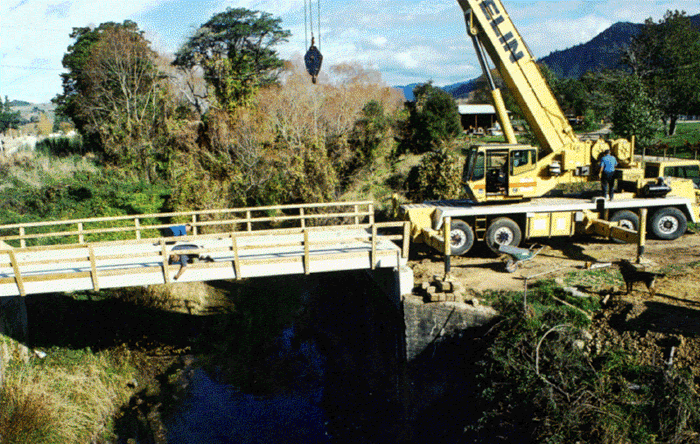Sherry River Bridges and improvements in water quality
Results
A poster of results of the cow crossing experiment displayed at the first bridge opening can be downloaded. ![]() 656KB
656KB
A poster on what happened to the water quality of the Sherry River once bridges went in.![]() 205 KB
205 KB
Presentation Rob Davies-Colley gave to Dairying and Environment Committee (DEC) Research Seminar, Livestock Improvement Centre, Newstead, Hamilton, 27-28, August, 2003. ![]() 1438 KB
1438 KB
Tasman District Council and Fonterra have also produced a 2 page flier about dairying and the clean streams accord that incorporates an action plan for the Tasman District. Clean streams accord. ![]() 1691KB
1691KB

Constructing Matariki bridge over Sherry River
(Media Release in May 2003 coinciding with bridge opening and a field day)
Farmers in the Sherry River are celebrating the opening of a new $50,000 farm bridge that marks the start of a project to improve the health of the Sherry River with the Tasman District Council (TDC).
Martin Workman, Policy Planner at TDC said "This is an example of farmers taking positive action to protect the environment. By taking a partnership approach, the farmers, council and scientists have shared information and identified practical solutions."
Water quality monitoring carried out in the Sherry River since October 2000 identified high bacteria levels (both faecal coliforms and camplyobacter) at certain times. This indicated the river is unsafe for swimming in its lower reaches. In comparison nutrients levels were relatively low.
The water quality monitoring is part of the Motueka Integrated Catchment Management Project (ICM). The project involves Tasman District Council, Landcare Research, the Cawthron Institute, and other science providers in a $1 million per annum project to study the impact of different land uses on the catchment and the coastal marine area. One of its aims is to find ways to get the results of science to end users, such as farmers.
The water quality information was presented to a meeting of the 8 major landowners in the Sherry in July 2001. The farmers expressed concern at the high bacteria results, especially as they and their families enjoy swimming in the river, but they wanted more monitoring to be done to identify what might be causing the problem.
As a result more detailed monitoring was carried out at 4 sites on the Sherry River. This showed that bacteria levels increased as you moved down the river, and particularly below the four dairy farms. However, it is recognised that this is not just a dairying issue, and that dry stock are also having an impact. The impact of using riverbeds for stand off pads was raised, and there was also concern that dairy cows crossing the river on a regular basis for milking were a major source of contaminants.
Scientists involved in the ICM project, from Landcare, Cawthron, NIWA and the Council studied the impact of cows crossing the river on their way to and from milking. This is the first scientific study of the impact on water quality of a stock crossing in our district and one of the few conducted nationally.
The study was very involved with video cameras, automatic samplers and "crap counters". The study showed that the herd of 246 cows crossing the Sherry River had a large impact on water quality. The concentration of faecal bacteria (E. coli) reached over 50,000 per 100ml of river water after the crossing, well over the 126 national guideline for swimming. The input of 250 billion faecal bacteria into the river from the crossing event was also of concern. This meant the impact of the crossing would not only be short term but would impact long term on the water quality as this large amount of bacteria worked its way down the river. The study also found that stock were 50 times more likely to void in the stream than on the race. This showed the benefit that a bridge would provide in reducing the amount of contaminants entering the river.
When presented with this additional information in December 2001 the Sherry farmers undertook to take action. In a short period of time the crossing on Frank and Lisa White's property where the experiment was carried out has now been bridged by Thelin Construction. In addition another farmer, Rod O'Beirne, is using a bridge instead of taking his herd through the river. Two other bridges are in the planning stages, and substantial fencing and planting to keep stock out of the river is under way. The Council is providing financial assistance for fencing and planting and free advice on bridge design.
The farmers are now monitoring the health of the river themselves to detect what changes occur after their actions. The Council will also be carrying out monitoring to see what changes in bacteria levels occur. Other projects identified for the farmers and Council to work together on include the control of crack willow and old man's beard along the river.
Already farmers are getting benefits from using the bridges as far as saving time and stress in getting cows to and from milking, and being able to get cows across the river when in flood (speak to Frank White about the benefits). Although the farmers are motivated by a desire to look after the river they can also see the benefit bridges provide to their business.
"The farmers in the Sherry are to be congratulated on their excellent response. The water quality of the Sherry River can be expected to significantly improve in the future," said Martin Workman. "The Council is looking to establish a similar partnership approach with farmers in other catchments, so that resorting to blanket rules requiring all stock crossings to be bridged can be avoided." Any landowners wanting to know more about the assistance the Council can provide should contact Martin at the council.